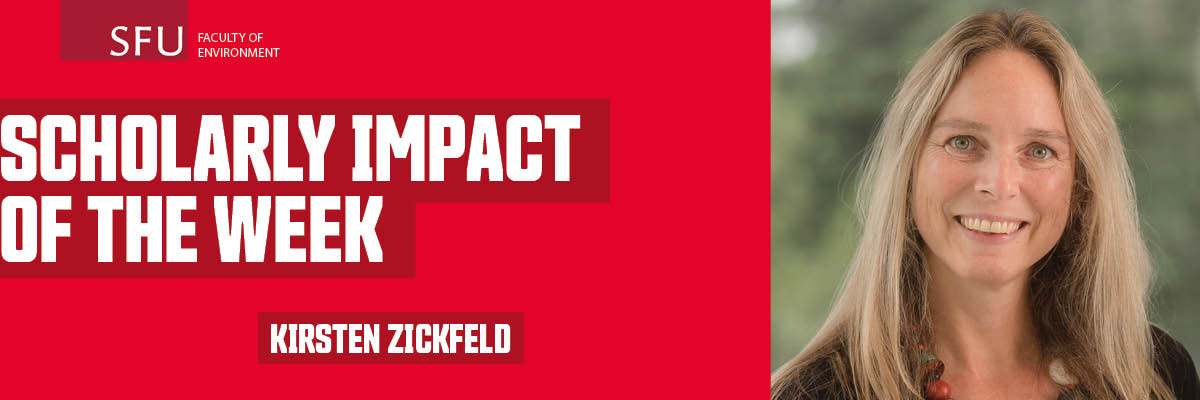
Nature-based solutions to capture carbon—such as reforestation and forest or peatland conservation—could help reach Paris Agreement climate goals, but only if paired with other aggressive carbon reduction strategies.
Distinguished SFU Professor of Climate Science Kirsten Zickfeld is director of the SFU Climate Research Lab, and investigates the long-term effects of human activities on climate. Zickfeld and her team collaborated with researchers from Concordia University and Microsoft on the study, Temporary nature-based carbon removal can lower peak warming in a well-below 2 °C scenario, recently published in Nature Communications Earth and Environment.
The study took into account that some nature-based carbon solutions may be temporary. Disturbances such as wildfires and human land-use priorities threaten the ability of nature to sequester and store carbon permanently. However, when used alongside ambitious emission reductions that are consistent with reaching net zero CO2 emissions by 2050, temporary nature-based carbon removal would decrease peak warming by as much as a tenth of a degree—an important and tangible climate benefit. Furthermore, the researchers argue that better nature conservation and stewardship can help build resilience to climate change while also offering many other benefits including increased biodiversity, improved water and air quality, and supporting the livelihoods and cultural values of communities.
We spoke with Professor Zickfeld about her research.
The study assumes that carbon sequestration through nature-based climate solutions could be temporary. Forests might succumb to fire, for example. Can you explain how even temporary solutions could benefit the climate?
The climate effect of nature-based carbon sequestration depends on the total amount of carbon that is permanently removed from the atmosphere. If carbon is first sequestered by planting trees and later returned to the atmosphere when these forests are destroyed by fire, the net carbon sequestration and therefore the effect on temperature is zero. However, in a scenario where fossil-fuel emissions reach net zero and global temperature peaks by mid century, temporary carbon sequestration can reduce the level of peak warming if the carbon is re-released after fossil-fuel emissions stop. If, on the other hand, carbon emissions from fossil fuels continue, temporary nature-based carbon sequestration would serve only to delay the temperature increase.
Which tools did you use to obtain your results?
We used a global Earth system model that represents the atmosphere, the land surface and the ocean, and the cycling of carbon, water and energy between them. The system is fully coupled—a change in one component, such as a change in land use affects all other components including the atmosphere and the ocean. Such a model is capable of simulating not only the effects of nature-based solutions on the cycling of carbon between the land and the atmosphere, but also other climate effects resulting from changes in albedo and evapotranspiration. This is an advantage over so-called “stand-alone” land models that are not interactively coupled to climate.
Your study took into account changes in albedo, the amount of sunlight reflected at the Earth’s surface. How do nature-based climate solutions affect the amount of sunlight that is reflected rather than absorbed?
Let’s take reforestation as an example. Trees are generally darker than grasses or crops, that is, they absorb more incoming sunlight. If forests replace grasslands or croplands, more solar radiation is absorbed, which has a warming effect. This warming counteracts the cooling effect that is achieved through carbon sequestration by the regrowing forest. Therefore it is important to consider albedo changes and other so-called biophysical climate effects when assessing the climate benefits of nature-based climate solutions.
Can you tell us more about the benefits of nature-based solutions, beyond carbon sequestration?
Many nature-based solutions that are considered for carbon sequestration have a range of other benefits. For example, conservation and restoration of ecosystems can improve biodiversity, and enhance other ecosystem services such as improved water and air quality. Agricultural practices that aim to retain more carbon in soils can also lead to higher productivity and food production. There are therefore many good reasons to invest in nature-based solutions, even if the carbon sequestration and climate benefits are modest.
Do you think nature-based climate solutions can help Canada achieve its emission reduction targets under the Paris Agreement?
Nature-based climate solutions are not a silver bullet. They can play a supporting role in achieving Canada’s emission reduction targets by offsetting greenhouse gas emissions that are very challenging to eliminate, but will need to be complemented by decarbonization in all sectors.
For more: Planting trees can help the climate, but only if we also stop burning fossil fuels, the Conversation.
SFU's Scholarly Impact of the Week series does not reflect the opinions or viewpoints of the university, but those of the scholars. The timing of articles in the series is chosen weeks or months in advance, based on a published set of criteria. Any correspondence with university or world events at the time of publication is purely coincidental.
For more information, please see SFU's Code of Faculty Ethics and Responsibilities and the statement on academic freedom.